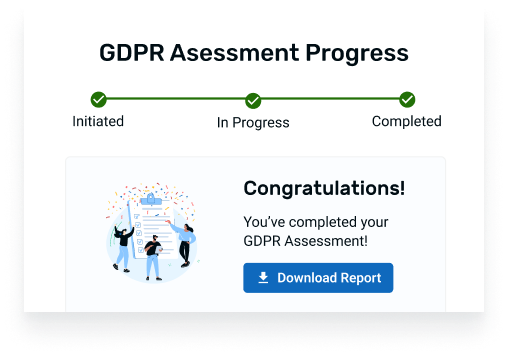The General Data Protection Regulation (GDPR) has transformed the data protection landscape, and understanding its implications is crucial for organizations around the world.
One aspect that often raises questions is the notion of “legitimate interest” as a lawful basis for processing personal data. How does it work, and how can organizations apply it correctly? In this post, we’ll dive into the intricacies of GDPR legitimate interest and provide practical insights to help you navigate this complex area with confidence.
Short summary:
- We’ll define the concept of legitimate interest, its role in GDPR compliance, and the importance of balancing it with data subject rights.
- Let’s explore real-life situations where legitimate interests might apply, such as fraud detection, network security, and employee/client data processing.
- Finally, we’ll discuss how to conduct a GDPR Legitimate Interest Assessment (LIA) and provide expert guidance on data privacy and GDPR compliance.
Let’s get started!
Understanding legitimate interest under GDPR
Legitimate interest is a lawful basis for data processing under GDPR, which allows organizations to process personal data for their own interests, as long as the interests or fundamental rights and freedoms of the data subject (usually the customer) are not compromised.
Organizations need to strike a balance between their legitimate interests and the rights of the data subjects.
The key to determining whether processing personal data based on legitimate interests is allowed under GDPR lies in weighing the benefits of data collection against the interests or fundamental rights and freedoms of the data subject.
It’s the business owner’s responsibility to ensure user privacy is safeguarded and that the legitimate interests pursued by the organization are balanced with the rights of the data subject.

What is GDPR legitimate interest?
In essence, legitimate interest applies when an organization uses personal data in a way that the data subject would expect, and the interests of the data subject are still respected.
One way to determine if legitimate interest can be applied for a specific purpose is by conducting a legitimate interest purpose test.
This test helps organizations assess whether legitimate interest is the most suitable legal basis for their data processing activities. Organizations must consider various questions before deciding if processing data based on legitimate interests is the right move.
Balancing data subject rights and legitimate interests
Data subject rights are essential for GDPR compliance, as they give individuals control over their personal data. Compliance with these rights is a must to avoid penalties and maintain customers’ trust.
In addition to adhering to data subject rights, organizations must be prepared to erase data upon objection via a Data Subject Access Request (DSAR). This means that individuals can ask for their data to be removed from the organization’s systems. Organizations need to make sure they have the right procedures in place to respond to these requests quickly and efficiently.
Protecting data subject rights when processing personal data
Under GDPR, data subjects have various rights, such as the right to access, rectify, erase, restrict processing, data portability, object to processing, and not be subjected to automated decision-making. Organizations must respect these rights and ensure that they comply with GDPR.
If organizations cannot justify their legitimate vital interests in data processing, they could face consequences. For instance, if individuals disagree with such interests, they can request the organization to remove their records with a DSAR. If the organization cannot prove its reasoning, it could be penalized for collecting data illegally.
Addressing objections and DSARs
A Data Subject Access Request (DSAR) is a way for individuals to obtain a full record of the data an organization has on them and why it was collected. Properly handling objections and DSARs under GDPR is crucial for organizations to maintain compliance and trust with their customers.
The best way to address objections and DSARs under GDPR is to create policies and procedures for evaluating objections from data subjects and document their handling of a DSAR thoroughly to show compliance with the GDPR. This includes providing individuals with a copy of any related information about them when responding to a DSAR.
Making it real: Situations in which legitimate interest might be applied
Now that we’ve established the concept of legitimate interest and its role in GDPR compliance, let’s delve into some real-life scenarios. It’s important to remember that each situation is unique, and organizations must carefully assess the legitimacy of their data processing activities in light of GDPR requirements.
Some examples of situations where legitimate interests may apply include fraud detection and crime prevention, network and information security, and processing employee or client data. In the following sections, we’ll explore each of these scenarios in more detail, providing practical insights into how legitimate interests can be applied effectively and responsibly.
Fraud detection and crime prevention
Legitimate interest can be applied in situations involving fraud detection and crime prevention, as data processing for these purposes usually passes the purpose test. This means that only the necessity and balancing tests need to be considered for a specific case.
Network and information security
In the realm of network and information security, legitimate interests can be used as a legal basis for processing personal data. Organizations must ensure that the necessary and proportionate processing of personal data is carried out for security purposes, as outlined in Recital 49 of the GDPR.
By relying on legitimate interests for network and information security, organizations can protect their systems and data from potential security threats while maintaining compliance with GDPR. Organizations must evaluate the potential impact of their data processing activities on data subjects and take necessary steps to mitigate any risks.
Processing and retaining employee or client data
Legitimate interest can also be applied to processing or retaining employee or client data, as long as there is a relevant and appropriate relationship between the data subject and the controller. Accenture has a privacy policy in place. It outlines the legal basis for data processing purposes such as communicating with candidates and selecting the best candidate for job openings.
In some cases, organizations may choose to retain the personal details of job applicants under the legitimate interest condition if they believe it would be beneficial to keep the data beyond the legally required six months, as the applicants might be suitable for future positions. This highlights the flexibility and practicality of legitimate interests as a legal basis for data processing under GDPR.
Direct marketing
Transparency is crucial when relying on legitimate interests for direct marketing purposes. Organizations must inform users about their data and how it’s being processed to maintain trust and credibility.
How to conduct a GDPR Legitimate Interest Assessment (LIA)
To ensure compliance with GDPR requirements and demonstrate that their legitimate interests are valid, organizations must conduct a GDPR Legitimate Interest Assessment (LIA). The LIA is a process that evaluates the potential effects of data processing activities on the data subject and takes necessary steps to reduce any risks.
The Information Commissioner’s Office (ICO) suggests a three-part test for conducting an LIA:
- Purpose: The purpose test helps determine if legitimate interest is the best legal basis for a specific data processing activity.
- Necessity: The necessity test examines whether the data processing is actually necessary to achieve the intended outcome.
- Balance: Finally, the balancing test evaluates if the data subject’s interests should take precedence over the legitimate interest.
By following this three-part test, organizations can ensure that their data processing activities are in line with GDPR requirements and maintain compliance.
Get expert guidance on data privacy and GDPR
Navigating the complexities of GDPR compliance and data privacy can be challenging for organizations. Seeking expert guidance can help businesses ensure they meet GDPR and protect their customers’ personal data.

Chat with our compliance experts: A free 15-Min AMA
Let’s chat. Connect with a compliance expert to find out how GDPR applies to your business—no strings attached. Book a chat here.
Our 5-step approach makes GDPR much easier to navigate:
- STEP 1: Kick-off. After a deep dive into data privacy, our experts customize your GDPR compliance roadmap
- STEP 2: Onboarding. Get up and running with GDPR policy templates, automated vendor discovery, and clear action items
- STEP 3: Implementation. Efficiently implement and operationalize GDPR with guided workflows, automation, and support from our experts
- STEP 4: GDPR assessment and reporting. As a third party, Thoropass delivers a transparent assessment and report to share with customers and prospects
- STEP 5: And beyond… Leverage our extensive platform to add frameworks, renew attestation, and ensure continuous compliance
Learn more about what your GDPR compliance journey with Thoropass will look like here!
Frequently asked questions about GDPR legitimate interest
What is a legitimate interest in GDPR?
A legitimate interest is when a company/organization processes personal data to fulfill its legitimate interests or the interests of third parties, as long as this does not outweigh an individual’s rights and freedoms. Such activities include maintaining customer relationships, direct marketing, fraud prevention, and ensuring the security of IT systems.
These activities must be balanced against the individual’s rights and freedoms, and the company/organization must be able to demonstrate that the processing is necessary and proportionate. This means that the company/organization must be able to show that the processing is necessary for the legitimate interests pursued.
What is the legitimate interest exception?
The Legitimate Interests Exception allows organizations to process personal data without consent in certain situations, as long as the processing is necessary for the legitimate interests of the organization and appropriate safeguards have been put in place to protect individuals’ privacy rights. This exception is a part of the PDPA amendments that came into effect on 1 February 2021.
What do legitimate interest cookies mean?
Legitimate interest cookies are used for interests other than the user’s consent. They can help increase security, improve website performance, and prevent fraud, all while providing a better experience for users.
Therefore, these cookies are important in ensuring that websites remain secure and provide satisfactory services.
What is the difference between consent and legitimate interest?
Put simply, consent is about providing customers with explicit permission to communicate with them, whereas legitimate interest provides brands with the opportunity to target and engage customers based on their own interests. Essentially, consent is gaining permission to contact a customer, whereas legitimate interest is more about using data for marketing purposes.
Start your GDPR Journey
Learn how Thoropass can help you get—and stay—GPDR compliant
Our experts (and Oro) are always here if you have any questions.

Related Posts
Stay connected
Subscribe to receive new blog articles and updates from Thoropass in your inbox.
Want to join our team?
Help Thoropass ensure that compliance never gets in the way of innovation.














.png)